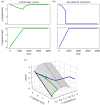Rate-induced collapse in evolutionary systems
- PMID:35642430
- PMCID: PMC9156909
- DOI: 10.1098/rsif.2022.0182
Rate-induced collapse in evolutionary systems
Abstract
Recent work has highlighted the possibility of 'rate-induced tipping', in which a system undergoes an abrupt transition when a perturbation exceeds a critical rate of change. Here, we argue that this is widely applicable to evolutionary systems: collapse, or extinction, may occur when external changes occur too fast for evolutionary adaptation to keep up. To bridge existing theoretical frameworks, we develop a minimal evolutionary-ecological model showing that rate-induced extinction and the established notion of 'evolutionary rescue' are fundamentally two sides of the same coin: the failure of one implies the other, and vice versa. We compare the minimal model's behaviour with that of a more complex model in which the large-scale dynamics emerge from the interactions of many individual agents; in both cases, there is a well-defined threshold rate to induce extinction, and a consistent scaling law for that rate as a function of timescale. Due to the fundamental nature of the underlying mechanism, we suggest that a vast range of evolutionary systems should in principle be susceptible to rate-induced collapse. This would include ecosystems on all scales as well as human societies; further research is warranted.
Keywords: collapse; evolutionary rescue; extinction; nonlinear dynamics; rate-induced tipping points.
Figures







Similar articles
- Fast environmental change and eco-evolutionary feedbacks can drive regime shifts in ecosystems before tipping points are crossed.Chaparro-Pedraza PC.Chaparro-Pedraza PC.Proc Biol Sci. 2021 Jul 28;288(1955):20211192. doi: 10.1098/rspb.2021.1192. Epub 2021 Jul 21.Proc Biol Sci. 2021.PMID:34284624Free PMC article.
- Macromolecular crowding: chemistry and physics meet biology (Ascona, Switzerland, 10-14 June 2012).Foffi G, Pastore A, Piazza F, Temussi PA.Foffi G, et al.Phys Biol. 2013 Aug;10(4):040301. doi: 10.1088/1478-3975/10/4/040301. Epub 2013 Aug 2.Phys Biol. 2013.PMID:23912807
- The stability and collapse of marine ecosystems during the Permian-Triassic mass extinction.Huang Y, Chen ZQ, Roopnarine PD, Benton MJ, Zhao L, Feng X, Li Z.Huang Y, et al.Curr Biol. 2023 Mar 27;33(6):1059-1070.e4. doi: 10.1016/j.cub.2023.02.007. Epub 2023 Feb 24.Curr Biol. 2023.PMID:36841237
- Ecological limits to evolutionary rescue.Klausmeier CA, Osmond MM, Kremer CT, Litchman E.Klausmeier CA, et al.Philos Trans R Soc Lond B Biol Sci. 2020 Dec 21;375(1814):20190453. doi: 10.1098/rstb.2019.0453. Epub 2020 Nov 2.Philos Trans R Soc Lond B Biol Sci. 2020.PMID:33131439Free PMC article.Review.
- Ecosystem tipping points in an evolving world.Dakos V, Matthews B, Hendry AP, Levine J, Loeuille N, Norberg J, Nosil P, Scheffer M, De Meester L.Dakos V, et al.Nat Ecol Evol. 2019 Mar;3(3):355-362. doi: 10.1038/s41559-019-0797-2. Epub 2019 Feb 18.Nat Ecol Evol. 2019.PMID:30778190Review.
Cited by
- Evolutionary shift of a tipping point can precipitate, or forestall, collapse in a microbial community.Blake C, Barber JN, Connallon T, McDonald MJ.Blake C, et al.Nat Ecol Evol. 2024 Dec;8(12):2325-2335. doi: 10.1038/s41559-024-02543-0. Epub 2024 Sep 18.Nat Ecol Evol. 2024.PMID:39294402
References
- Folke C, Carpenter S, Walker B, Scheffer M, Elmqvist T, Gunderson L, Holling CS. 2004. Regime shifts, resilience, and biodiversity in ecosystem management. Annu. Rev. Ecol. Evol. Syst. 35, 557-581. (10.1146/annurev.ecolsys.35.021103.105711) - DOI
- Lenton TM. 2013. Environmental tipping points. Annu. Rev. Environ. Res. 38, 1-29. (10.1146/annurev-environ-102511-084654) - DOI
- Scheffer M. 2020. Critical transitions in nature and society. Princeton, NJ: Princeton University Press.
Publication types
MeSH terms
Related information
LinkOut - more resources
Full Text Sources
